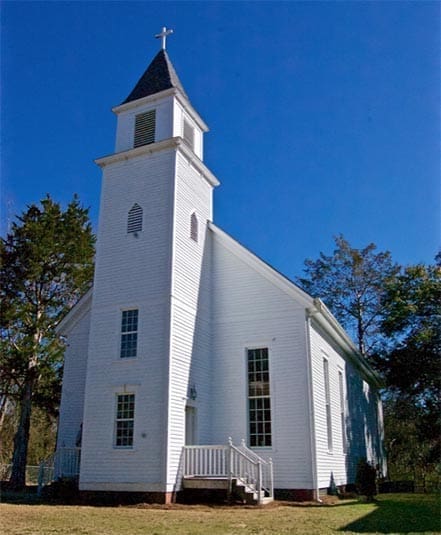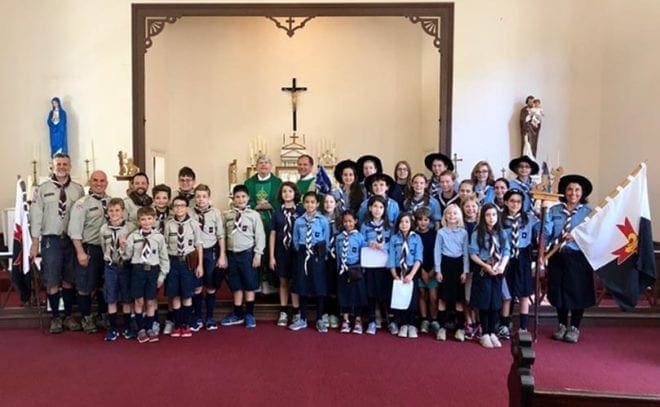 Photo Courtesy of Purification Heritage Center
Photo Courtesy of Purification Heritage CenterSharon
Historic Catholic center thrives in east Georgia
By SAMANTHA SMITH, Staff Writer | Published November 14, 2019
SHARON—Catholics looking for a historic and sacred place to renew their faith can discover what is considered “the cradle of Catholic Georgia.”
Purification Heritage Center, located some 100 miles east of Atlanta, is serving groups for day retreats that include Mass, walking pilgrimages and lunch. During the trip, visitors are immersed in the history of the Purification of the Blessed Virgin Mary Church, Locust Grove Cemetery and life of early Catholics in Georgia.
On Feb. 1, 2017, Archbishop Wilton D. Gregory, now archbishop of Washington, officially named the church, cemetery and land of the early Catholic community a heritage center. The center has three regular Masses each year, held on the Feast of the Purification, All Souls’ Day and Christmas Eve.
So far, Purification Heritage Center has welcomed many guests, including middle school students from Christ Our King and Savior Church in Greensboro, archdiocesan seminarians and monks from the Monastery of the Holy Spirit in Conyers.
People like to visit because “they feel like it’s a very sacred place,” said Betsy Orr, board member for the heritage center. “People want to come to get away.”
Early Catholic life in Georgia
“The vitality of the faith here was something,” said Orr about the early days of the church located in Sharon.
The first Church of the Purification served English Catholics from Baltimore who arrived in what is now Taliaferro County to establish a farming community. The community came to be known as Locust Grove. The original 1790 church was a simple log cabin building. The adjacent cemetery dates back to 1794.

The Church of the Purification of the Blessed Virgin Mary in Sharon is considered to be “the cradle of Catholic Georgia.” The Purification Heritage center includes the church, Locust Grove Cemetery and land of the early Catholic community. Photo Courtesy of Purification Heritage Center
The next wave of settlers was French Catholics fleeing revolution in their country, followed by Irish Catholics. Between 1818 and 1821, the Sisters of St. Joseph, a French order, arrived and established the first Catholic school in Georgia, chartered as Locust Grove Academy. Three governors of Georgia were educated there. In 1821, the original church was replaced by a larger structure. Locust Grove in the 1840s was the center of Catholic life in Georgia.
But that changed within a generation, as the railroad altered community life. A railroad line to the west made Sharon more attractive. Settlers selected that community and Locust Grove shrank. In 1877, the Church of the Purification relocated to Sharon. The wood frame church was dismantled for the move. The current church was built in 1883.
Restoration in progress
The Georgia Trust for Historic Preservation added Purification Church to its list of “Places in Peril” in 2014. Orr sent a donation and was later contacted about being more involved with the project.
Now a resident of nearby Washington, Orr is very hands on, helping with the development of the center and preparing the space for visitors.
In 2014, Friends of the Purification, consisting of mostly lay Catholics, initiated a campaign to save the Purification of the Blessed Virgin Mary Church. With the first campaign, they were able to make updates to the church, which included replacing and restoring windows, removing lead paint and rotten wood, repainting, restoring the bell tower and bringing the building up to code.
The Locust Grove Cemetery was cleaned as well—70 percent of the headstones are now cleaned and turned correctly. Many family members of those buried in the cemetery helped to clean the space. As people cleaned the headstones, some began to pray for those who died. “That just happens organically,” said Orr.
Phase two of the restoration plans is in process, which includes adding bathrooms, parking and a landscaped walkway and fence around the cemetery. Within the next few years, phase three will begin, which includes building an outdoor chapel, lake, rosary walk, community garden and eventually cabins and a barn for people to use for overnight retreats. In the past six months, the Purification Heritage Center became an official nonprofit, charitable organization.
A lot has been accomplished, but there is more to do, explained Amanda Hailey, a board member for the center.
Fulfilling a vision
The mission of the Purification Heritage Center is to “provide a welcoming Catholic environment that serves local and faith communities through beauty, peace and historical connection.” Its vision and motto is “a sacred place to seek, find and renew faith.”
While the community in Sharon and neighboring Washington is not predominantly Catholic, Orr has found support from locals on the work to preserve the history.

The Federation of North American Explorers visit the Purification Heritage Center on Sept. 22. The Atlanta group made a two mile walking pilgrimage from the church to the cemetery. Photo Courtesy of Purification Heritage Center
“We have been so delighted,” she said.
There are many ways to support the Purification Heritage Center, including donations and volunteering for various tasks. Supporters or “Friends of Purification” receive e-newsletters and help spread the word on the center. “Parish Champions” keep their parishes informed on upcoming events.
Support has come from many in the Atlanta Archdiocese. Msgr. Richard Lopez donated a crucifix to the church and students from Christ the King School have helped to decorate the church for Christmas. Seminarians and monks from the monastery plan to make regular visits to the center.
The Purification Heritage Center is a “great example of how laity can serve the church,” said Orr.